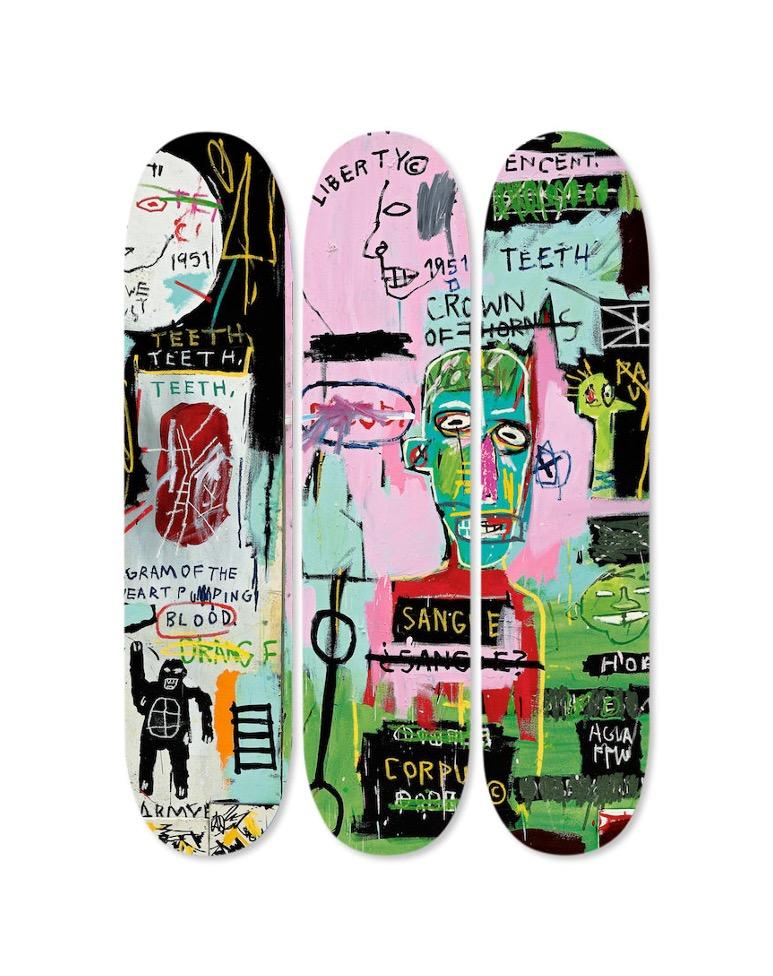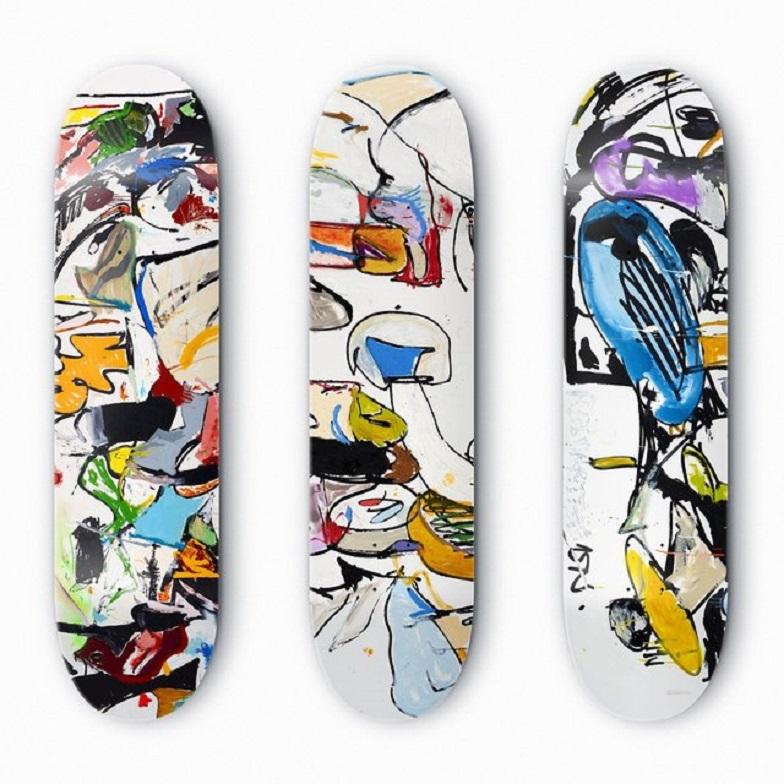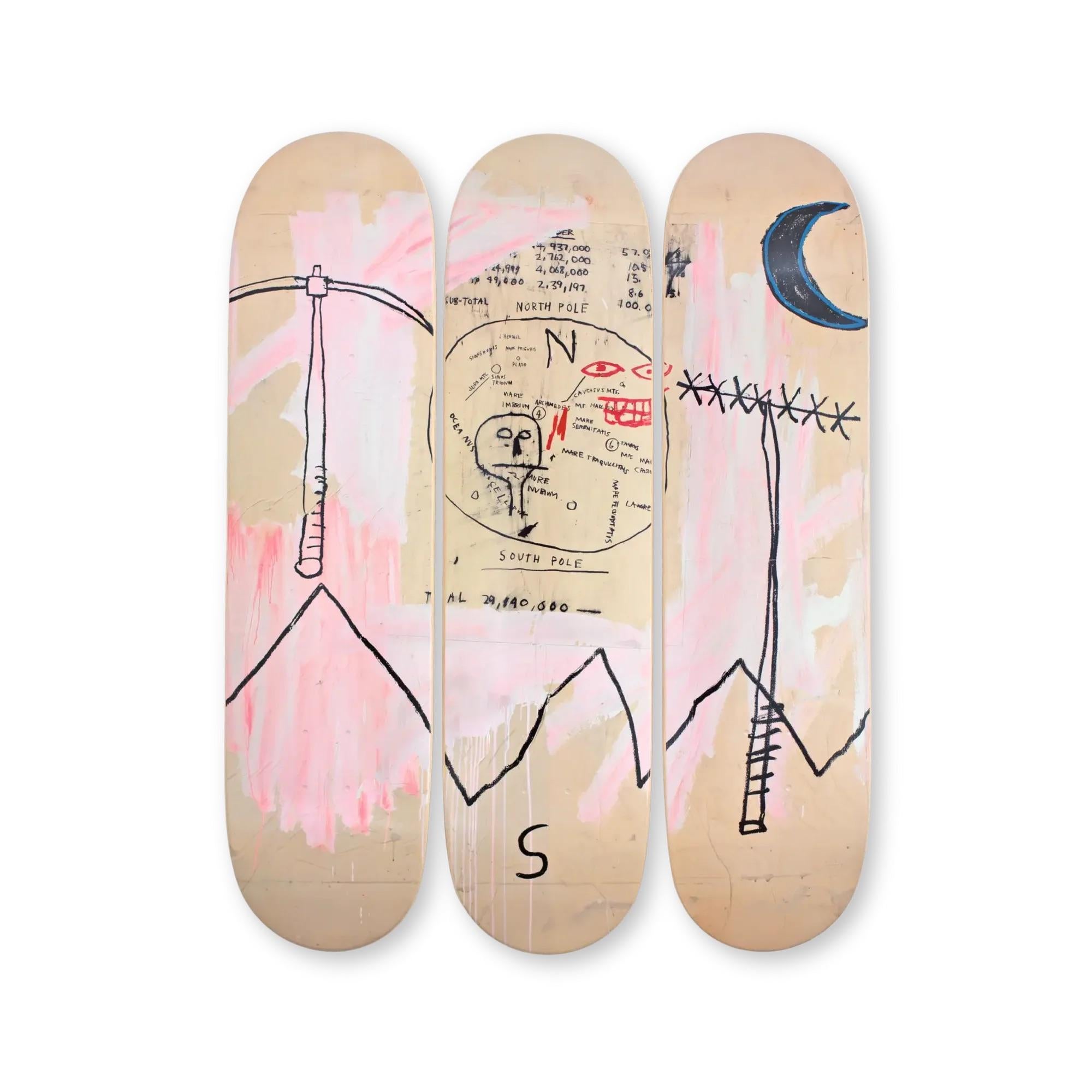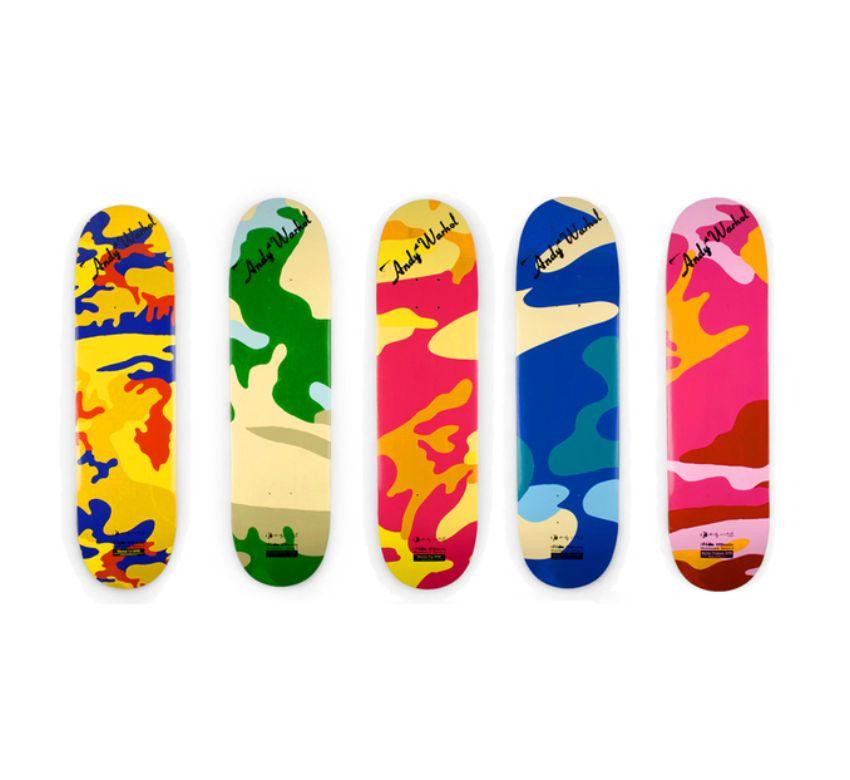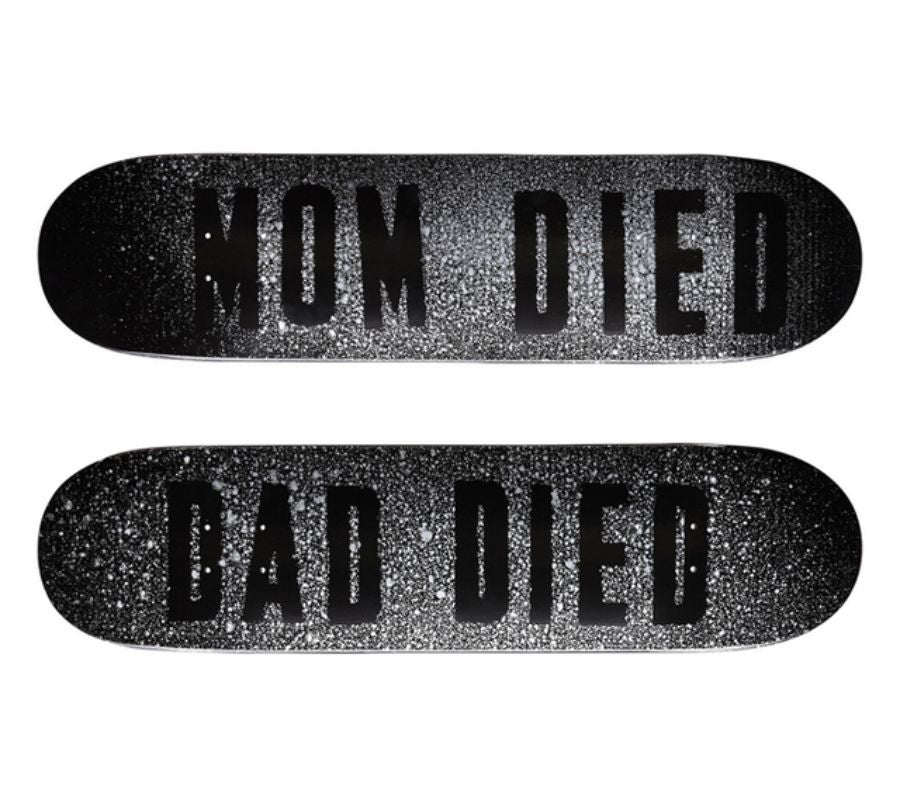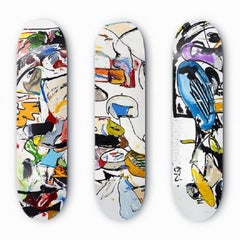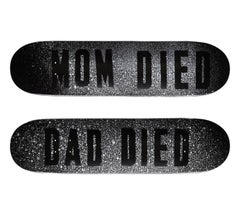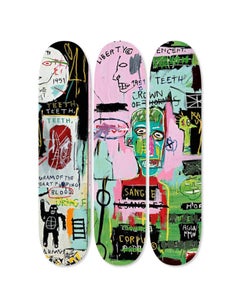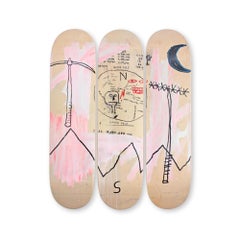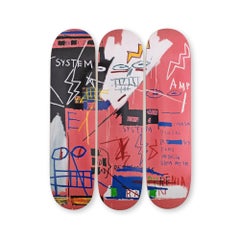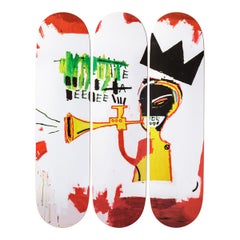Items Similar to Ads Series skateboards set of 5
Want more images or videos?
Request additional images or videos from the seller
1 of 2
Ads Series skateboards set of 52012
2012
$2,850
£2,212.28
€2,509.43
CA$4,069.34
A$4,484.09
CHF 2,325.82
MX$53,332.23
NOK 29,421.01
SEK 27,561.24
DKK 18,741.65
About the Item
Ads Series skateboards set of 5
- Creation Year:2012
- Dimensions:Height: 31 in (78.74 cm)Width: 7.5 in (19.05 cm)Depth: 1 in (2.54 cm)
- Medium:
- Movement & Style:
- After:Andy Warhol (1928 - 1987, American)
- Period:
- Condition:
- Gallery Location:Washington , DC, DC
- Reference Number:1stDibs: LU171329784432
About the Seller
5.0
Vetted Professional Seller
Every seller passes strict standards for authenticity and reliability
Established in 2008
1stDibs seller since 2022
74 sales on 1stDibs
Typical response time: Several days
- ShippingRetrieving quote...Shipping from: Washington , DC, DC
- Return Policy
More From This Seller
View AllSkateboard set
By Andy Warhol
Located in Washington , DC, DC
Skateboards made in conjunction with the Estate of Andy Warhol
Category
21st Century and Contemporary Contemporary Prints and Multiples
Materials
Screen, Wood
$2,850
SIGNED ed. 100 Skateboard set of 3
By Eddie Martinez
Located in Washington , DC, DC
SIGNED ed. 100 Skateboard set of 3
Category
21st Century and Contemporary Contemporary More Art
Materials
Maple, Plywood, Screen
Camouflage (set of 5 skateboard decks)
By Andy Warhol
Located in Washington , DC, DC
Extremely rare set of 5 skateboard decks produced by Maharishi in 2007 from a very small edition of only 100. Made in conjunction with the Warhol Foundation.
Category
21st Century and Contemporary Contemporary Prints and Multiples
Materials
Screen, Board
$3,600 Sale Price
20% Off
Supreme skateboards set of 2
By Mark Flood
Located in Washington , DC, DC
Supreme skateboards set of 2
Category
21st Century and Contemporary Contemporary Prints and Multiples
Materials
Screen
$1,480 Sale Price
77% Off
Untitled
By Jean-Michel Basquiat
Located in Washington , DC, DC
Set of 5 skateboard decks
Publisher: Estate of Jean Michel Basquiat in collaboration with Artestar
Please see our other listings
Category
21st Century and Contemporary Contemporary Prints and Multiples
Materials
Wood, Screen
$6,500
Camouflage skateboards set of 3
By Andy Warhol
Located in Washington , DC, DC
Rare set of skateboards featuring Andy Warhol's Camouflage series. Produced in conjunction with the Warhol Foundation
Category
21st Century and Contemporary Contemporary More Art
Materials
Screen
You May Also Like
In Italian Skateboards Set of 3
By Jean-Michel Basquiat
Located in Central, HK
The Skateroom x Estate of Jean-Michel Basquiat
In Italian Skateboard Triptych, 2014
7 ply Grade A Canadian Maple wood (Set of 3)
31 1/2 × 7 9/10 in 80 × 20 cm
Open edition
Licensed...
Category
2010s More Art
Materials
Wood, Maple
JEAN-MICHEL BASQUIAT - Both Poles. Skate Decks Pop Urban Art Design
By Jean-Michel Basquiat
Located in Madrid, Madrid
Jean-Michel Basquiat - Both Poles
Date of creation: 2024
Medium: Digital print on Canadian maple wood
Edition: Open
Size: 80 x 20 cm (each skate)
Condition: In mint conditions and never displayed
This triptych is formed by three skate decks made of 7 ply grade A Canadian maple wood.
© Estate of Jean-Michel Basquiat. Licensed by Artestar, New York
This skateboard set reproduces Both Poles (1982), an iconic work by Jean-Michel Basquiat that encapsulates the tensions running through his visual language: past and present, earth and sky, history and immediacy. The original piece, executed in acrylic, oil stick, and collage, presents a fragmented scene dominated by a symbolic mountain, a crescent moon, and charged elements such as a sickle and a post.
Here, Basquiat confronts “both poles” of his inner and outer worlds: excavation and invocation, memory and transmission. This edition brings that conceptual force into the urban language of skateboarding, becoming both a collectible object and a contemporary artistic statement.
Transposed onto the skateboard format, the work becomes a visual declaration that bridges art and street culture, while preserving the expressive and conceptual intensity of the original.
ABOUT THE ARTIST
Jean-Michel Basquiat (1960-1988) was one of the most influential artists of the 20th century, famous for his ability to fuse urban culture, social criticism and art history into a unique style. Born in Brooklyn, New York, to a Haitian father and Puerto Rican mother, his life and work were shaped by his multicultural heritage, the New York art scene and the social tensions of his time. Although his career was brief, his impact on contemporary art has been lasting and significant.
Basquiat showed an interest in art from an early age. His mother, Matilde Andrades, took him to museums and encouraged him to draw. At the age of seven, a car accident left him hospitalized for a time, and it was then that his mother gave him a copy of the anatomy book Gray's Anatomy, which influenced his fascination with the human body and its visual representation.
Despite his early talent, Basquiat's family life was turbulent. His mother was hospitalized for psychiatric problems and his relationship with his father, Gerard Basquiat, was troubled. This instability contributed to Basquiat dropping out of school at age 17 to pursue his artistic career on the streets of New York.
As a teenager, Basquiat joined the New York graffiti scene under the pseudonym SAMO (an acronym for "Same Old Shit"), which he used to sign his cryptic and poetic messages on the streets of Manhattan with his friend Al Diaz. SAMO's graffiti were a mixture of philosophical and social commentary on popular culture, capitalism and religion, and soon attracted the attention of the underground art scene.
In 1980, SAMO "died" when Basquiat and Diaz decided to end their collaboration, marking the beginning of Basquiat's transition from street graffiti to art galleries.
Basquiat emerged as a talent to watch in 1980, when he participated in the group exhibition The Times Square Show, which included other emerging artists from New York's Lower East Side scene. That same year, he attracted the attention of critics and collectors who saw in his work an electrifying blend of street art and neo-expressionism, the predominant movement of the time.
In 1981, art critic René Ricard published the influential essay The Radiant Child in Artforum magazine, which positioned Basquiat as one of the most promising artists of his generation. Shortly thereafter, he met renowned artist Andy Warhol, with whom he formed a close friendship and significant artistic collaboration. This association was instrumental in catapulting his career into the world of high art.
The collaboration with Warhol was a pivotal point in Basquiat's career. The two artists, although coming from very different worlds, shared a fascination with fame and popular culture. Together, they produced a series of works that combined Warhol's pop art icons with Basquiat's raw, spontaneous style.
However, this collaboration was also a source of controversy. Many critics accused Warhol of "exploiting" Basquiat, while others saw the collaboration as a creative dialogue between two genius minds. Although the criticism was mixed, there is no doubt that the relationship between the two artists helped cement Basquiat's reputation in the art world.
Basquiat's style is a unique amalgam of influences. His work is characterized by the use of dismembered human figures, skeletons and internal organs, evoking the fragility of the body and mortality. Basquiat also used symbols that alluded to African-American and African history, such as crowns, masks and references to historical figures such as Toussaint Louverture.
The use of text is another crucial aspect of his work. Words, phrases and numbers appeared in his paintings, often crossed out or overlapped, creating a sense of controlled chaos. These fragmented words provoked a non-linear reading of his works and conveyed multiple layers of meaning.
His art also reflected his concerns about racial issues, especially the place of people of African descent in Western art history and in society at large. The crowns that Basquiat often drew on his figures were a symbol of power and resistance, a way of proclaiming himself "king" in a world that had historically excluded black artists from the upper echelons of art.
In works such as The Death of Michael...
Category
2010s Pop Art More Art
Materials
Wood, Digital
JEAN-MICHEL BASQUIAT - Six Fifty. Skate Decks Pop Urban Art Design
By Jean-Michel Basquiat
Located in Madrid, Madrid
Jean-Michel Basquiat - Six Fifty
Date of creation: 2024
Medium: Digital print on Canadian maple wood
Edition: Open
Size: 80 x 20 cm (each skate)
Condition: In mint conditions and never displayed
This triptych is formed by three skate decks made of 7 ply grade A Canadian maple wood.
© Estate of Jean-Michel Basquiat. Licensed by Artestar, New York
Six Fifty (1982) powerfully distills the symbolic universe and raw energy that define Jean-Michel Basquiat’s artistic language. In this piece, the artist uses a loaded iconography—lightning bolts, bones, swords, arrows, crowns—that serves as a kind of visual alphabet through which he explores themes of identity, violence, power, and cultural heritage.
With his gestural and spontaneous style, Basquiat turns the canvas into a field of tension between chaos and control, between the urgency of the street and the depth of critical thought. Like much of his work, this piece does not seek a single interpretation but instead opens multiple layers of meaning through graphic elements that seem to arise directly from the urban subconscious.
Six Fifty is not just a visual representation—it is a visceral statement, a fragment of the noise and pulse of 1980s New York, where Basquiat emerged as a radical voice in contemporary art. His ability to combine the immediacy of graffiti with historical, anatomical, and cultural references is fully evident here.
ABOUT THE ARTIST
Jean-Michel Basquiat (1960-1988) was one of the most influential artists of the 20th century, famous for his ability to fuse urban culture, social criticism and art history into a unique style. Born in Brooklyn, New York, to a Haitian father and Puerto Rican mother, his life and work were shaped by his multicultural heritage, the New York art scene and the social tensions of his time. Although his career was brief, his impact on contemporary art has been lasting and significant.
Basquiat showed an interest in art from an early age. His mother, Matilde Andrades, took him to museums and encouraged him to draw. At the age of seven, a car accident left him hospitalized for a time, and it was then that his mother gave him a copy of the anatomy book Gray's Anatomy, which influenced his fascination with the human body and its visual representation.
Despite his early talent, Basquiat's family life was turbulent. His mother was hospitalized for psychiatric problems and his relationship with his father, Gerard Basquiat, was troubled. This instability contributed to Basquiat dropping out of school at age 17 to pursue his artistic career on the streets of New York.
As a teenager, Basquiat joined the New York graffiti scene under the pseudonym SAMO (an acronym for "Same Old Shit"), which he used to sign his cryptic and poetic messages on the streets of Manhattan with his friend Al Diaz. SAMO's graffiti were a mixture of philosophical and social commentary on popular culture, capitalism and religion, and soon attracted the attention of the underground art scene.
In 1980, SAMO "died" when Basquiat and Diaz decided to end their collaboration, marking the beginning of Basquiat's transition from street graffiti to art galleries.
Basquiat emerged as a talent to watch in 1980, when he participated in the group exhibition The Times Square Show, which included other emerging artists from New York's Lower East Side scene. That same year, he attracted the attention of critics and collectors who saw in his work an electrifying blend of street art and neo-expressionism, the predominant movement of the time.
In 1981, art critic René Ricard published the influential essay The Radiant Child in Artforum magazine, which positioned Basquiat as one of the most promising artists of his generation. Shortly thereafter, he met renowned artist Andy Warhol, with whom he formed a close friendship and significant artistic collaboration. This association was instrumental in catapulting his career into the world of high art.
The collaboration with Warhol was a pivotal point in Basquiat's career. The two artists, although coming from very different worlds, shared a fascination with fame and popular culture. Together, they produced a series of works that combined Warhol's pop art icons with Basquiat's raw, spontaneous style.
However, this collaboration was also a source of controversy. Many critics accused Warhol of "exploiting" Basquiat, while others saw the collaboration as a creative dialogue between two genius minds. Although the criticism was mixed, there is no doubt that the relationship between the two artists helped cement Basquiat's reputation in the art world.
Basquiat's style is a unique amalgam of influences. His work is characterized by the use of dismembered human figures, skeletons and internal organs, evoking the fragility of the body and mortality. Basquiat also used symbols that alluded to African-American and African history, such as crowns, masks and references to historical figures such as Toussaint Louverture.
The use of text is another crucial aspect of his work. Words, phrases and numbers appeared in his paintings, often crossed out or overlapped, creating a sense of controlled chaos. These fragmented words provoked a non-linear reading of his works and conveyed multiple layers of meaning.
His art also reflected his concerns about racial issues, especially the place of people of African descent in Western art history and in society at large. The crowns that Basquiat often drew on his figures were a symbol of power and resistance, a way of proclaiming himself "king" in a world that had historically excluded black artists from the upper echelons of art.
In works such as The Death of Michael...
Category
2010s Pop Art More Art
Materials
Wood, Digital
Trumpet (Set of 3 Skatedecks)
By Jean-Michel Basquiat
Located in Central, HK
The Skateroom x Estate of Jean-Michel Basquiat
Trumpet Skateboard Decks, set of three works, 2019
Screen Print on 7-ply Canadian Maple Wood.
31 1/2 × 8 in 80 × 20.3 cm
Open edition ...
Category
2010s More Art
Materials
Wood, Maple
Unfinished Business SkateDeck
Located in Draper, UT
Joshua Vides, Unfinished Business Skate Deck in original packaging.
Category
2010s Street Art Mixed Media
Materials
Wood
Paul Insect I SEE Skateboard Deck Set Of 3 Beyond The Streets Signed XX/101 COA
By Paul Insect
Located in Draper, UT
Paul Insect:
Paul Insect is a UK contemporary artist. Best known for his collective named ‘insect’ that started in 1996 he is a collage, portrait master w...
Category
2010s Pop Art More Prints
Materials
Screen
More Ways To Browse
Series Of Art Prints
Skateboard Art
Skateboard Set
Ballet Dancer
Ceramic Art Sculpture Contemporary
Nude Fine Art
American Ballet Theater
1972 Print
Hand Signed Numbered Lithograph Limited Edition
19th Century Etchings
Prints Of 18th Century Paintings
Underwater Photography
Miro Lithographs
Photos Of Artists
Vintage Book Illustrations
German Print Early 20th Century
Germany Prints Early 20th Century
Art Sculptures Pop Art

